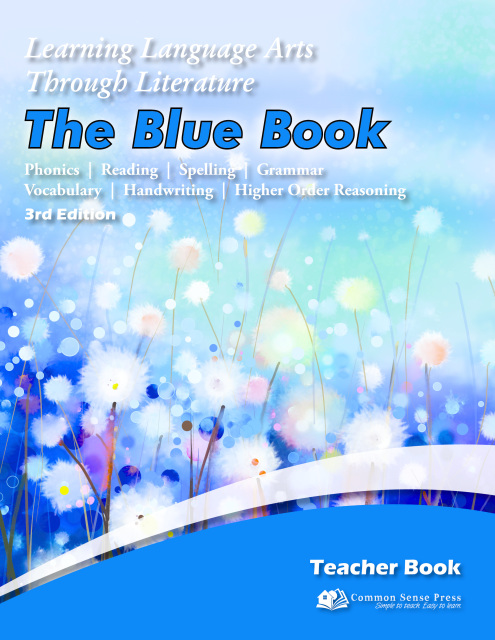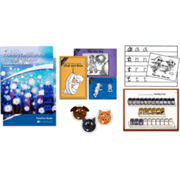The Learning Language Arts Through Literature series begins with The Blue Book. This complete beginning phonics and language arts program artfully integrates phonics instruction with all of the other areas of language arts that need to be covered at first grade level: reading skills, spelling, handwriting, and grammar. The course also teaches more higher-order thinking skills than do many other first grade programs.
Based on Dr. Ruth Beechick's ideas about learning, the course does not assume that children learned to read in kindergarten. However, children should be able to identify letters, and it would be very helpful if they know some or most of the primary sounds of the letters. Early in the course, the first group of letters—a, n, r, and t—is introduced. In this same lesson, students learn about consonants and vowels as well as blending letters to form words. This progression will likely be too fast for children who do not already know letters and sounds.
The course teaches with many hands-on activities and incorporates real books along with the program's readers. Those who like Charlotte Mason's approach to education will probably like Dr. Beechick's as well, although there are minor differences. For example, while some questions ask for specific answers, many are open-ended as Charlotte Mason recommends.
The Blue Book program comes in a boxed set that includes the teacher manual, the student activity book, three sets of beginning readers (28 readers in all), and a materials packet. The consumable student activity book can also be purchased separately for additional students.
The third edition student workbooks are now printed in full color, probably the most noticeable improvement over the second edition course. Pages are well designed with plenty of space for tracing, writing, drawing, and other activities. Some pages (blank on the reverse side) will be removed from the student workbook and used for activities and the creation of small books.
Many types of activities are built into the lessons so that students learn through all of their senses. This approach is especially good for wiggly students with short attention spans. Students work with color-coded letters, phonograms, and words, and specially designed letter dice. These items are cut out (and sometimes put together) from heavy cardstock pages in the materials packet.
Immediately after students learn the first few letters and sounds, they are introduced to the first readers to experience the fun of actually reading. The readers are small with black-line illustrations. They are similar to the popular Bob Books, but the illustrations in the readers that come with The Blue Book course look more professional and the stories are sometimes humorous.
The teacher manual has detailed lesson plans, but they are not scripted. However, they do tell you what to show, tell, ask, etc. in a step-by step fashion. Some preparation time is required to plan ahead and collect materials like books from the library, glue, crayons, markers, popsicle sticks, and old catalogs or magazines. Materials needed are listed at the beginning of each lesson in the teacher manual.
As part of many of the lessons, parents read stories to the student from storybooks constructed from the student activity book as well as from popular children's books that can be found at the library. Many of the included stories are fanciful, including some Aesop's Fables and other tales. The content is wholesome, but not overtly Christian.
Spelling and grammar instruction is truly integrated within the lessons rather than being treated as two additional isolated subjects as we find in most programs. Handwriting receives some separate attention as students are taught letter formation then practice those forms. The style of handwriting is unusual: it is a straight up and down style of printing, but it has an unusual italic/slant print look because most horizontal lines and curves are drawn on a slant. This style is used throughout the handwriting lessons but not on the movable-letter cards or in the readers. This is neither good nor bad, just different. You can select another handwriting style to teach, but you will need to re-create the handwriting worksheets if you do so.
The phonics coverage begins with letters and sounds then continues through long- and short-vowels, and consonant blends. However, you will need to continue with the next course, The Red Book, to complete coverage of all phonograms.
The Blue Book requires more preparation and presentation time than do some other programs. However, the program impresses me as being one of the most interesting from a child's point of view.











